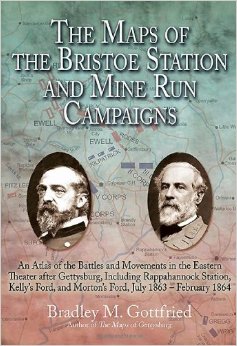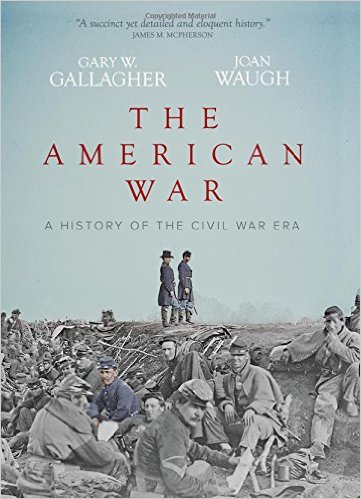The Maps of the Bristoe Station and Mine Run Campaigns: An Atlas of the Battles and Movements in the Eastern Theater after Gettysburg, Including Rappahannock Station, Kelly’s Ford, and Morton’s Ford, July 1863-February 1864 by Bradley M. Gottfried. Savas Beatie, 2013. Cloth, ISBN: 9781611211528. $34.95.
 The rolling fields and rusted railroad tracks of Bristoe Station Battlefield Heritage Park, just a few minutes’ drive from Manassas, comprise one of the hidden gems of northern Virginia’s Civil War history. Despite its location, however, the dramatic action at Bristoe between Gouverneur Warren’s federals and A.P. Hill’s Confederates remains part of what can only be termed the “fly-over” period of the Eastern Theater narrative. Wedged between the clash at Gettysburg in July 1863 and the first meeting of Grant and Lee in May 1864, the series of autumn movements between George Gordon Meade and Robert E. Lee has never garnered the attention it deserves. All but the most seasoned Civil War historians typically ignore these campaigns.
The rolling fields and rusted railroad tracks of Bristoe Station Battlefield Heritage Park, just a few minutes’ drive from Manassas, comprise one of the hidden gems of northern Virginia’s Civil War history. Despite its location, however, the dramatic action at Bristoe between Gouverneur Warren’s federals and A.P. Hill’s Confederates remains part of what can only be termed the “fly-over” period of the Eastern Theater narrative. Wedged between the clash at Gettysburg in July 1863 and the first meeting of Grant and Lee in May 1864, the series of autumn movements between George Gordon Meade and Robert E. Lee has never garnered the attention it deserves. All but the most seasoned Civil War historians typically ignore these campaigns.
With the fifth title in its Military Atlas Series, Savas Beatie has published Dr. Bradley Gottfried’s treatment of the Bristoe Station and Mine Run Campaigns, and it is a welcome addition to the military literature of the Civil War. Gottfried’s volume rivals David Powell’s Maps of Chickamauga as the most useful in this series, offering the same expertise Civil War readers have come to expect from Gottfried’s previous reference works (The Brigades of Gettysburg, The Maps of Gettysburg, The Maps of Antietam, and The Maps of First Bull Run). As with the other books in this series, each map is paired with a page of text explaining the strategic and tactical situation on the ground. Gottfried possesses a keen ability to contextualize complex operations succinctly. To his credit, Gottfried also delves frequently into logistics, including Meade’s contempt for the Orange and Alexandria Railroad as a line of communication and supply. (An honest understanding of logistics usually separates an authoritative operational history from a poor one.) But Gottfried is at his best when describing the assault of the Sixth Corps at Rappahannock Station and Regis de Trobriand’s actions the same day at Kelly’s Ford, overlooked instances of the offensive capabilities of the Army of the Potomac.
Although Gottfried wrote this book as a reference work, he is not above leveling criticism at some of the actors involved in the Bristoe Station and Mine Run dramas. Principal blame for the Confederate disaster at Bristoe Station belongs at the end of the day to Lee, he declares, since the commanding general failed to coordinate Hill and Ewell in their blundering, headlong attempts to crush Warren’s Second Corps before it escaped (74). A few more offhand judgments court controversy, such as Gottfried’s statement that “of [Meade’s] remaining corps leaders, only VI Corps’ John Sedgwick showed real command promise” (2). What of Warren? Or perhaps even Howard, as Allen Guelzo’s Gettysburg: The Last Invasion might invoke? But readers hoping for a decisive review of Meade’s generalship will come away somewhat disappointed. Of Meade’s command abilities, “neither Bristoe Station nor Mine Run provided a conclusive answer to that fundamental question,” Gottfried asserts (176). The best modern study of Meade’s actions and motivations that autumn remains Ethan Rafuse’s short but reliable George Gordon Meade and the War in the East, soon to be matched (and perhaps even surpassed) by Christopher Stowe’s forthcoming biography of the general.
None of these minor quibbles should detract from what is really a valuable addition to any Civil War library —a book that can finally fill that embarrassing void on the shelf between Gettysburg and the Wilderness. As it is, only a handful of books detail the campaigns discussed here in any detail, including William Henderson’s The Road to Bristoe Station; Martin Graham and George Skoch’s Mine Run; and, most recently, Adrian Tighe’s self-published but well-received Bristoe Campaign. Part of what makes Gottfried’s volume remarkable, then, is that he simply did not have the advantage of a critical mass of secondary literature from which to draw. Instead, he conjured these impressive maps and particular operational details (down to the skirmish lines, in many cases) from a careful study of mostly primary materials. And the result is an impressive operational study.
A book titled The Maps of the Bristoe Station and Mine Run Campaigns begs to be judged on the merits of what it is, after all – an atlas. But Gottfried has given us much more than a simple book of battlefield maps with blocks, dotted lines, and arrows. Students of the war’s Eastern Theater should purchase this unique book while they can because it offers the best and most coherent narrative of the actions in northern Virginia between Gettysburg and the Wilderness. And then, after they have read it, they can walk the fields of Bristoe Station and enjoy the same level of tactical detail afforded by books on the much more famous battle up north.
Zachery A. Fry is a Ph.D. candidate at The Ohio State University.
